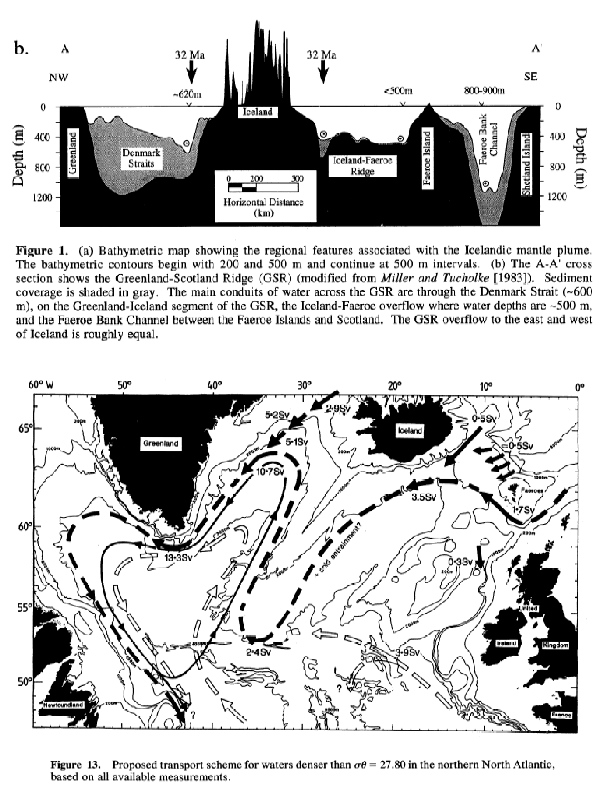Following up from last month, the first results from the real-time monitoring of the thermohaline circulation were presented by Harry Bryden at the RAPID conference in Birmingham last week. I wasn’t there, so you should go to RealClimate and read Gavin’s analysis, as he was. This quote sums up the major news:
There were two key observations: first, that the approximations that had been used in the Bryden et al study were actually valid, and secondly, that the variations day by day varied by around 5 Sv (1 Sv is about 10 times the flow of the Amazon). The mean over the year for the MOC was 18 Sv.
It seems that over timescales of a few days there are fairly sizeable shifts in the amount of North Atlantic Deep Water (NADW) crossing the 25oN transect. These results pretty much destroy any hope of extracting any meaningful long-term trend from the existing data set of decadally spaced, one-time snapshots of the circulation; the ‘weakening’ from 23 to 15 Sv since 1957 proposed in Bryden et al.’s Nature paper last year is very close in magnitude to the observed natural variability (and their 2004 hydrographic section underestimated the average strength of the present circulation by 2 Sv). In an interview with the BBC, Bryden still seems fairly convinced there is some weakening of the circulation (by 10% in the last 25 years rather than 30%), but I think the jury’s out on even that at this stage.
I’m wondering whether Nature is going to follow up on the fact that one of their headline papers was a little premature (no luck so far...), but as Gavin points out, the media seem to have missed the down-sized estimate in their excitement over the curious 10 day period in November 2004 when the southwards flow of NADW was weak to non-existent (see here, for example). According to someone else I know who attended the talk, Harry Bryden ‘just dropped this in’, and it’s certainly not in his abstract. Why? Because at the moment no-one really has any idea how this could happen. To understand the confusion we need to look a little further north. NADW is principally formed by cold saline water sinking in the Norwegian Sea, but as the figures below shows, the route south is not simple, because it’s path is along the seabed is blocked by the Greenland-Scotland Ridge (GSR), part of the volcanic edifice which Iceland sits atop of. The top figure[1] shows how the GSR acts as a sort of dam, with three or four ‘sills’ at bathymetric lows acting as spillways which spilt the NADW into different currents. The bottom figure [2] shows how these currents all join back together at the southern end of Greenland and head south as one big water mass.

Why is this important? It means that the apparent shut down of the THC is not because there was a temporary hiatus in NADW production (due to, say, freshening of the surface waters due to particularly strong seasonal melting in the Artic). The different routes taken by the NADW over the GSR all take different times, so any cessation in downwelling would not simultaneously cut off all the currents coalescing south of Greenland. There will always be some water. So, if this is a real signal, the whole water mass seems to have somehow been held up in the northern Atlantic somewhere, which seems a little weird. We scientists like weird, or course, but at this stage we need more data: how often do these ‘mini-shutdowns’ happen? Are they seasonal/cyclical or random? I think much more interesting stuff is going to come out of this array over the next few years – not least a robust estimate of the longer term trends in the circulation.
Newer developments:
The Case of the THC "Shutdown"
[1] From Wright & Miller (1995), Paleoceanography 11(2), p157-170.
[2] From Dickson & Brown (1994), JGR 99(C6), p12319-41.




No comments:
Post a Comment